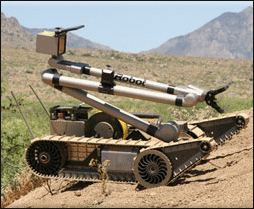Robotics isn’t only the thing of science fiction that most consider it to be.
Personal robots have always been adept at war. But now they’re getting better at doing some of the more mundane things, such as fetching medicine for the elderly and chasing dust balls around the room.
“Robotics is a large part of the solution,” said Colin Angle, CEO and co-founder of iRobot, a Massachusetts company best known for developing and selling a robotic vacuum cleaner.
The toughest job, said Angle, is not developing such systems as the Roomba and floor-washing Scooba, but convincing people that they actually interact with people and extend the reach of health care workers through Internet connections and wireless technology.
Hospitals are also looking to mingle sophisticated imaging systems with precise mechanics to create robots that perform operations that are beyond even the most expert surgeon.
One project, for example, involves using robots to remove a blood clot from the micro vessels in a human eye.
A lot of the non-military robotics research money is now being spent on developing systems that can provide cheaper personal care to the elderly, said Angle. Driving this development are skyrocketing health care costs, overcrowded and understaffed nursing homes, and an aging population that includes health care workers.
About a third of all nurses are 50 years or older, and 40 percent will be older than 50 by 2010. The challenge of caring for the elderly is getting more expensive, he said.
Relying on a robot for personal care may be a tough sell, however, since most people think of these as either cute little Star Wars droids or human-hating battle-bots straight from Hollywood central casting.
Not much is being done to change that image. At a recent conference on the future of robotics, sponsored by Boston University’s Department of Manufacturing and Engineering, most of the presentations focused on the war-time use of robots and other military machines that worked without much human intervention.
 |
An iRobot Packbot. Source: iRobot |
Angle said iRobot is also working with the Defense Advanced Research Planning Agency (DARPA) to develop bomb-sniffing Packbots that are designed to protect soldiers from landmines and other improvised explosive devices (IEDs).
Networked prototypes are also being tested that pinpoint a sniper’s gunshot, triangulate the position and instantly tell soldiers where to direct their fire to take the sniper out.
There are now more than 300 Packbots in use in Iraq, Afghanistan and other military hotspots worldwide, said Angle, who added that the idea is “to keep soldiers out of the casket.” There is also a cost-savings involved, since it costs millions to train and deploy each soldier and tens of thousands for each small robot.
The benefits of robotics to the military also go well beyond the “dull, dirty and dangerous,” said Stephen Welby, director of DARPA’s Tactical Technology Office.
Remote control and robotics airplanes have been used since World War II and now are an important part of the war in Iraq. Included in the robot arsenal are eight giant Global Hawk and 60 Predator unmanned aircraft, he said.


